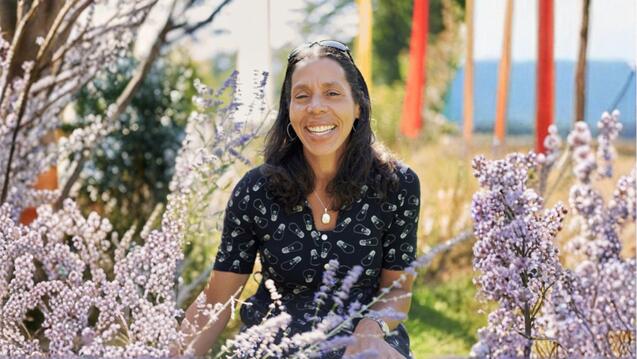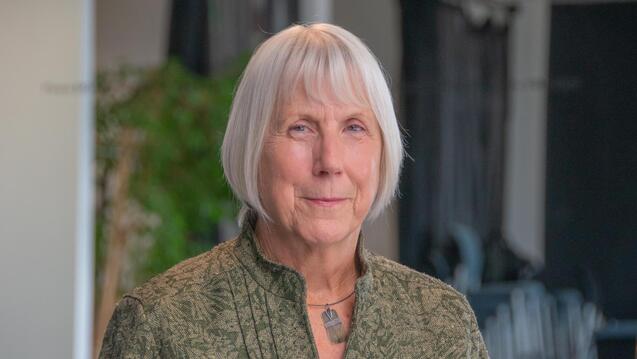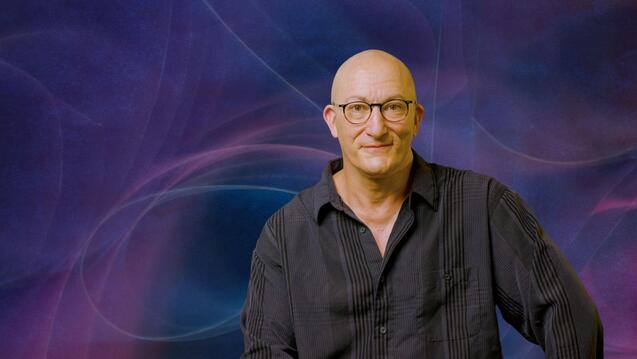Professor Jeanine Canty explores how the Transformative Studies Ph.D. prepares visionary changemakers to address humanity's disconnection from nature and each other.

How the Future Happens: An Interview with Professors Alfonso Montuori and Gabrielle Donnelly
CIIS professors Alfonso Montuori and Gabrielle Donnelly discuss editing The Routledge Handbook for Creative Futures, a 37-chapter, globally diverse handbook on creative, collaborative approaches to envisioning hopeful futures.
Professors Alfonso Montuori and Gabrielle Donnelly are the kind of colleagues who finish each other’s sentences. Oh, not familiar with those? Well, maybe you should be. That’s certainly their philosophy: namely, that more people should have—and be—the kind of academics who transform the faculty/student hierarchy into an equitable partnership, celebrating each other’s strengths and supporting each other’s learning.
Donnelly was previously a student of Montuori in the Transformative Studies Ph.D. program, but the two don’t stand on the kind of ceremony that often beleaguers academia. Instead, they have a confident give and take of ideas, which makes them perfect editors for a volume on creativity. Specifically, the Routledge Handbook for Creative Futures (the CIIS community can access it via the Rockefeller Library), a treatise of extraordinary breadth and depth, with 37 chapters and more than 50 contributors, whose diversity of age, ethnicity, culture, discipline, gender, geography, and other identities make for a deeply representative sample of the many perspectives this topic can inspire. Donnelly and Montuori celebrate the differences among contributors as much as they do their own: it’s easy to see that they work well together not in spite of their contrasting approaches, methods, and ideas, but because they come from such different places, but with such obvious mutual respect and curiosity.
Alfonso and Gabrielle, thank you so much for speaking with us about your work. First, what inspired Handbook for Creative Futures?
Prof. Alfonso Montuori: For me, the future has always been an interesting topic. I did my dissertation about it, way back, and have written a couple of books and several articles on the topic. Mostly my interest came about because I grew up living in different countries. All these different countries had aspects that I really liked and things that were very problematic. And I always thought, couldn't we just draw on elements from these different cultures and create a world where people wouldn't dismiss others as quickly? That was my attitude as a kid. Most recently it was triggered again because I was speaking to so many people, old and young, and particularly young, who didn't seem to have any sense that the future was going to be anything but dystopian. That really motivated me to want to put this book together. It was motivated also by my interest in creativity and this sense that there seems to be a lack of imagination when it comes to thinking about the future. What has caused that? Why are we stuck and unable to envision other futures, or at least a sense of possibilities?
Prof. Gabrielle Donnelly: Part of my background is that I grew up in a spiritual community that actively prepared for an apocalyptic event in the 1990s. My early years were partly shaped by an immersive experience of preparing for the end of the world. Seeing the power of a vision for the future and how others were galvanized around it, for better or worse, certainly struck me.
Alfonso and I began our collaboration because of my interest in facilitation and group process. Oftentimes the work that I'm doing as a facilitator is to support people in thinking about the future together. I'm interested in ideas of social creativity, of how groups imagine the future together. How can we work in generative, supportive ways to create compelling visions for the future that can hold commonality and difference simultaneously? I think there's great power in the images of the future that circulate in the world.
In terms of the book itself, one of the big pieces as we were pulling it together was a recognition of how many causes for despair there are today. When we decided on the topic of creative futures, it was really about how we can build that creative muscle for other possible futures. It’s not about uncritical optimism. And at the same time, we didn't want to get pulled into cynicism. What is this place of intelligent optimism in cultivating creative possibilities, and practicing our ways into them?
You seem very aligned on the subject now; were you originally clear on how you would shape the topics and structure of the book?
GD: I was working as managing editor of World Futures, and Routledge reached out to us and said, we would really love to publish a handbook on world futures. Would you be willing to pull that together? I was still early on in my academic career, and so I volunteered—with some naivety and enthusiasm, because it turns out it’s a lot of work! But I'm so glad we did it. Alfonso, I'm trying to remember the evolution. You and I were in conversation, and it just felt like a traditional handbook of futures studies wasn't compelling enough for us.
AM: Yes, they originally just wanted us to do a handbook of future studies, which just sounded very dull. [laughs] Instead, we ended up doing something that we've been talking about for quite a while, this idea of creative futures, an approach to the future that wasn't the traditional futurist approach, which in the early days used to be prediction and then became scenario planning.
Recent research suggests that rather than only being driven by the past, we’re also driven by the future we expect. And if our image of the expected future is miserable, we will act accordingly. Young couples aren't having kids because of environmental anxiety; some aren't even saving because they're so concerned that the world's going to hell in a hand basket. So the image we have of the expected future is really important, and since these days people mostly expect dystopias, we wanted to mobilize creativity and expand the space of possibilities.
GD: I would add that the word creative comes from both your background as a creativity researcher and your interest in creativity as an artist and a musician. And for me, it was this idea of social creativity, which was massively under-researched.
What was it like to collaborate in that new pressurized environment, especially with regard to your existing student teacher relationship? How did it evolve?
GD: This all came together in 2019 and it felt like great timing. I was two years into a tenure track position at Acadia University, two years since I’d graduated. I was ready to embark on a bigger project. It was a moment when Alfonso and I probably could have drifted away from working together because my work was changing and I was at a different university, but we were still open to collaborating. I did take up the big role of administrative and logistical responsibilities, which helped. (Not Alfonso’s strong suit.)
When I look back, I can't name the moment our collaborative relationship shifted, but it certainly did. People in my life would say, “you're so comfortable with him,” and I think it’s because I could tease you. And I do. [laughs] I feel like we meet as intellectual equals, and I appreciate how Alfonso, you’ve encouraged that over time. How was that transition for you, working with me as a student and then gradually as a full collaborator?
AM: I've always enjoyed collaborations in writing projects. They can be fun, they can be stimulating, there's a certain conviviality. I play sax and flute, two instruments that almost always require other players, and sometimes it’s great and other times not so great. One of the good things about academia is the tradition of faculty and students working together. In the beginning think there's a tendency for students early on to think of faculty more in the way that you might think of your teacher in high school, and you put them in a little box based on the class they teach, but you don't think of developing a collaborative relationship and working on a project with them. With Gabrielle, it was obvious to me that we were having great conversations, shared a lot of interests, she had passion and she had a lot of capacities that balanced out so many of the things that I was just not particularly good at. And I'm certainly not talking about the administrative stuff, which I do really suck at, but in terms of her background working with groups. [To Gabrielle] You were very sophisticated, and by 2019 you had been doing consulting work and working with groups for a long time at a high level. I'd already put together a number of edited books, so I knew what the deal was there. I just saw it as something I've done before and you haven't. There’s a match there in terms of what I bring to the table and what Gabrielle brings to the table and I think it allows us to combine those elements in ways that have been very generative and very enjoyable. And I think there is something about the process of you completing your Ph.D. and getting a full-time job that also says, now we're done with that stage, right? You're not my student anymore. [They exchange nods.] Right. So there’s a symbolism in that transition.
GD: One of the great things about our collaboration is that we share an orientation, but we have important differences and some tension that sharpens our work. When we’re writing together, we're in dialogue with each other around the edges of our questions and the edges of our work. That just keeps it exciting and fresh. It certainly shaped who we invited to contribute. It was very intentional for us to have people in all stages of their careers. We wanted to reflect those generational differences alongside people from every continent. We invited academics, but we also invited practitioners and activists. We had such a full range of contributors keeping in mind gender, race, and ability. And I think that our own generational differences, our gender differences, all of these things played out in great ways for us to explore all of the different facets of this emerging concept.
This was right around the time the pandemic started, right? You definitely had a lot of challenges from the get-go in getting the Handbook finished. How did your creativity kind of rise to that challenge?
AM: Yeah, I should mention that one of the things that happened is that, because of COVID and other reasons, some people declined. But we also had one contributor decline because he just couldn't see it. He couldn't see the possibility of creative futures. This is a major futurist who had actually written about the future in that more optimistic vein, so it was interesting to see the extent to which all sorts of people were giving up, thinking there's just nothing we can do about our current global situation. That's what we're battling against. But maybe you want to talk about that, Gabrielle, because you did a great job interviewing a number of people for the book.
GD: The initial invitations went out in late 2019 and early 2020. That was the time in the pandemic where we were all in our homes, (those of us who are housed). There was a phase in the early parts of the pandemic when people chose to do something collectively, when creative possibility actually felt quite close. Skylines were clearing from pollution for the first time in people's lifetimes. They could see mountains. There were these incredible examples of how humans can actually change course. And then it started to unravel, went back to “normal” and to increasing polarization. While human beings are incredible at adapting and changing in profound ways when change is thrust upon us, it’s also very hard to alter the momentum of habits and patterns that have taken hold already. The book took longer because of the pandemic, but I'm really glad that it did, because by the time it was published, it felt like none of our contributors were writing from any particular moment in the pandemic. It was coming from that collective experience, although experienced quite differently and in inequitable ways. We were clear we didn’t want the pandemic to timestamp the volume, while also recognizing it as part of the context.
Alfonso, was there a particular moment that you see this book coming from, or was it similarly grounded in the entire pandemic?
AM: For me, one of the interesting things that started happening was when I told people what this book was about and found the response was surprisingly good. A lot of people would comment that they hadn’t thought about this idea of creative futures, this idea of not just focusing on what we don't want, but looking at what we do want, about the impact of our expectation of the future on the present, and the need to mobilize the imagination. I was surprised to see enthusiasm from people young and old, and very heartened. Being able to think about the future in a different way is important, because in my experience, many people don’t really want to think about the future at all – it’s too scary. This different way of approaching it turns out to be very inviting.
To go back for a minute to the student faculty relationship, I think ultimately if there was really a significant moment, it was actually in creating this book, because Gabrielle clearly took the lead, putting the book together and contributing the interviews and being the first editor. There's a symbolism there in that transition. I've put together a bunch of edited books and every time I do, I say I'm never going to do this again. But I'm really glad we took on this project, and I think you are too Gabrielle, right?
GD: There's no regret. [laughs] I will be better prepared next time, though.
AM: Yeah, there was a lot going on for both of us. If we do an edited book again, we definitely won’t have 50-odd contributors scattered all over the world during a pandemic. [laughs]
Speaking of the contributors, how did the Handbook change your outlook for thinking about the future along with other people, not just with each other?
GD: One of the unexpected parts of the book for me was seeing the theme in various chapters emerge of the importance of reckoning with the past and the present for creative futures. That it's not just an orientation forward, but it is also a recognition of where we come from, and how that overlaps and shapes and informs the future. I think there's a natural affinity at CIIS for the concept of creative futures, and why many of the contributors are from CIIS.
AM: Right, like Nermin Soyalp, whose dissertation Historical Traumas was later published. That's always a joy when you see alumni driven by their own desire to contribute and to follow up on what they're doing here. And there’s Nick Walker, another brilliant alumna, and now a faculty member in the BAC program, contributed a fabulous chapter.
GD: And Jeanine [Canty] has a book recently published that is also the topic of the chapter in Creative Futures.
Can you say a little bit more about the Transformative Inquiry department and how that plays with creative futures?
AF: Transformative Studies [the Ph.D.] is a research program and Transformative Leadership [the M.A.] is a practitioner program for leaders. We know leadership is changing, and the old models are failing even as we are seeing a resurgence of authoritarian leaders, which is par for the course in times of transition, with all the chaos and confusion. Transformative leaders are really people who are in the process of recreating themselves and working for more creative futures.
The Transformative Studies Ph.D. a transdisciplinary degree, so it's not boxed into one discipline when thinking about all the issues related to the future. You need to be able to get the bigger picture and address the complexity of life. Academia doesn't always prepare us to do that because it focuses very much on analysis and breaking things down and hyper-specialization. But you also need people who can look at the big picture and integrate material from multiple areas. It’s about a different relationship with knowledge.
Gabrielle, what was your experience as a Ph.D. student? How do you feel like your relationship to knowledge or your relationship to these silos changed?
GD: It just opened up the world for me in really big ways. I could take a question from the world rather than filling a gap in literature. I could pull from my experience as the heart of my inquiry and then bring in research and scholarship to shed light on that question. I feel immensely grateful for this program; the person that I am now, and the ways that I think about the world, I really owe that to this program. I'm teaching first year students in a doctoral program now, and seeing some of their delight and sense of homecoming, having found a program that meets their needs and their larger sense of purpose. It’s a wonderful sense of continuity. That’s how the future happens.
Related Academic Programs
Transformative Inquiry Department
Related News
Dr. Janis Phelps founded the world's first academically approved psychedelic therapy training program, preparing clinicians for a transforming field of mental health.
Explore CIIS’ groundbreaking Bachelor’s program and the bold vision behind its creation.



